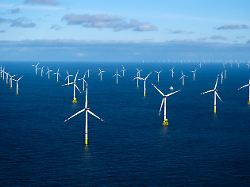“It also affects price developments”
Bottlenecks in the grid: Offshore wind power supplies less electricity
January 28, 2024, 9:33 a.m
Listen to article
This audio version was artificially generated. More info | Send feedback
The wind turbines in the North Sea could supply significantly more electricity. However, they always have to be shut down due to overloaded networks. As a result, the yield fell last year – according to experts, this is also noticeable in the costs.
The offshore wind turbines in the North Sea, which are important for the energy transition, delivered less electricity last year than in the previous year due to bottlenecks in the onshore network. A total of 19.24 terawatt hours (TWh) of wind energy was transferred to land, said the network operator Tennet. That is around nine percent less than in 2022. In purely mathematical terms, the 19.24 TWh could cover the annual needs of around six million households.
“Due to the still numerous bottlenecks in the onshore power grid, the large wind farms in the North Sea are increasingly having to be shut down,” said Tennet Managing Director Tim Meyerjürgens. Another reason: There are hardly any large conventional power plants in the north that could be throttled down instead. “This not only affects the amount of electricity fed in, but also affects its price development.”
In the north more green electricity is produced than consumed, in the south it is the other way around. That’s why more electricity needs to be transported from north to south. Because the construction of the “Südlink” and “Südostlink” high-voltage lines has been delayed for years, the line capacity is often not sufficient. Then green electricity systems – including many wind turbines in the north – will be “curtailed”. In the south, conventional power plants, which produce much more expensive electricity, have to be started up. “It is not always possible to transport electricity from the generation plants to the consumers,” says a spokesman for the Federal Network Agency diplomatically.
Operator calls for rapid network expansion
Tennet put the total wind power generation on land and at sea in Germany at 148.97 TWh in 2023 – 26.18 TWh more than in the previous year. The share of North Sea electricity fell by around four percentage points to around 13 percent. According to Tennet, the wind turbines in the Baltic Sea – they are in the 50 Hertz network area – generated 4.17 TWh last year. That was 0.55 TWh more than in 2022.
The capacity of wind farms in the German North Sea increased by 70 megawatts to 7,106 megawatts last year. Meyerjürgens called for a continued high pace in network expansion and the construction of large electricity highways “so that the North Sea’s potential as a wind power plant in Germany and Europe can be used efficiently as soon as possible.” The German energy industry is expecting additional billions in costs to stabilize the German power grid in the next few years.
